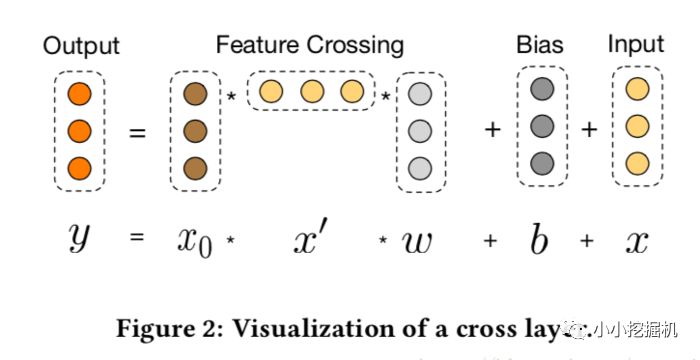

一个DCN模型从嵌入和堆积层开始
电子说
描述
1、原理
Deep&Cross Network模型我们下面将简称DCN模型:
一个DCN模型从嵌入和堆积层开始,接着是一个交叉网络和一个与之平行的深度网络,之后是最后的组合层,它结合了两个网络的输出。完整的网络模型如图:

嵌入和堆叠层
我们考虑具有离散和连续特征的输入数据。在网络规模推荐系统中,如CTR预测,输入主要是分类特征,如“country=usa”。这些特征通常是编码为独热向量如“[ 0,1,0 ]”;然而,这往往导致过度的高维特征空间大的词汇。
为了减少维数,我们采用嵌入过程将这些离散特征转换成实数值的稠密向量(通常称为嵌入向量):

然后,我们将嵌入向量与连续特征向量叠加起来形成一个向量:

拼接起来的向量X0将作为我们Cross Network和Deep Network的输入
Cross Network
交叉网络的核心思想是以有效的方式应用显式特征交叉。交叉网络由交叉层组成,每个层具有以下公式:

一个交叉层的可视化如图所示:

可以看到,交叉网络的特殊结构使交叉特征的程度随着层深度的增加而增大。多项式的最高程度(就输入X0而言)为L层交叉网络L + 1。如果用Lc表示交叉层数,d表示输入维度。然后,参数的数量参与跨网络参数为:d * Lc * 2 (w和b)
交叉网络的少数参数限制了模型容量。为了捕捉高度非线性的相互作用,模型并行地引入了一个深度网络。
Deep Network
深度网络就是一个全连接的前馈神经网络,每个深度层具有如下公式:

Combination Layer
链接层将两个并行网络的输出连接起来,经过一层全链接层得到输出:

如果采用的是对数损失函数,那么损失函数形式如下:
总结
DCN能够有效地捕获有限度的有效特征的相互作用,学会高度非线性的相互作用,不需要人工特征工程或遍历搜索,并具有较低的计算成本。论文的主要贡献包括:
1)提出了一种新的交叉网络,在每个层上明确地应用特征交叉,有效地学习有界度的预测交叉特征,并且不需要手工特征工程或穷举搜索。2)跨网络简单而有效。通过设计,各层的多项式级数最高,并由层深度决定。网络由所有的交叉项组成,它们的系数各不相同。3)跨网络内存高效,易于实现。4)实验结果表明,交叉网络(DCN)在LogLoss上与DNN相比少了近一个量级的参数量。
这个是从论文中翻译过来的,哈哈。
2、实现解析
本文的代码根据之前DeepFM的代码进行改进,我们只介绍模型的实现部分,其他数据处理的细节大家可以参考我的github上的代码:
https://github.com/princewen/tensorflow_practice/tree/master/Basic-DCN-Demo
数据下载地址:
https://www.kaggle.com/c/porto-seguro-safe-driver-prediction
不去下载也没关系,我在github上保留了几千行的数据用作模型测试。
模型输入
模型的输入主要有下面几个部分:
self.feat_index = tf.placeholder(tf.int32, shape=[None,None], name='feat_index') self.feat_value = tf.placeholder(tf.float32, shape=[None,None], name='feat_value') self.numeric_value = tf.placeholder(tf.float32,[None,None],name='num_value') self.label = tf.placeholder(tf.float32,shape=[None,1],name='label') self.dropout_keep_deep = tf.placeholder(tf.float32,shape=[None],name='dropout_deep_deep')
可以看到,这里与DeepFM相比,一个明显的变化是将离散特征和连续特征分开,连续特征不再转换成embedding进行输入,所以我们的输入共有五部分。
feat_index是离散特征的一个序号,主要用于通过embedding_lookup选择我们的embedding。feat_value是对应离散特征的特征值。numeric_value是我们的连续特征值。label是实际值。还定义了dropout来防止过拟合。
权重构建
权重主要包含四部分,embedding层的权重,cross network中的权重,deep network中的权重以及最后链接层的权重,我们使用一个字典来表示:
def _initialize_weights(self): weights = dict() #embeddings weights['feature_embeddings'] = tf.Variable( tf.random_normal([self.cate_feature_size,self.embedding_size],0.0,0.01), name='feature_embeddings') weights['feature_bias'] = tf.Variable(tf.random_normal([self.cate_feature_size,1],0.0,1.0),name='feature_bias') #deep layers num_layer = len(self.deep_layers) glorot = np.sqrt(2.0/(self.total_size + self.deep_layers[0])) weights['deep_layer_0'] = tf.Variable( np.random.normal(loc=0,scale=glorot,size=(self.total_size,self.deep_layers[0])),dtype=np.float32 ) weights['deep_bias_0'] = tf.Variable( np.random.normal(loc=0,scale=glorot,size=(1,self.deep_layers[0])),dtype=np.float32 ) for i in range(1,num_layer): glorot = np.sqrt(2.0 / (self.deep_layers[i - 1] + self.deep_layers[i])) weights["deep_layer_%d" % i] = tf.Variable( np.random.normal(loc=0, scale=glorot, size=(self.deep_layers[i - 1], self.deep_layers[i])), dtype=np.float32) # layers[i-1] * layers[i] weights["deep_bias_%d" % i] = tf.Variable( np.random.normal(loc=0, scale=glorot, size=(1, self.deep_layers[i])), dtype=np.float32) # 1 * layer[i] for i in range(self.cross_layer_num): weights["cross_layer_%d" % i] = tf.Variable( np.random.normal(loc=0, scale=glorot, size=(self.total_size,1)), dtype=np.float32) weights["cross_bias_%d" % i] = tf.Variable( np.random.normal(loc=0, scale=glorot, size=(self.total_size,1)), dtype=np.float32) # 1 * layer[i] # final concat projection layer input_size = self.total_size + self.deep_layers[-1] glorot = np.sqrt(2.0/(input_size + 1)) weights['concat_projection'] = tf.Variable(np.random.normal(loc=0,scale=glorot,size=(input_size,1)),dtype=np.float32) weights['concat_bias'] = tf.Variable(tf.constant(0.01),dtype=np.float32) return weights
计算网络输入
这一块我们要计算两个并行网络的输入X0,我们需要将离散特征转换成embedding,同时拼接上连续特征:
# model self.embeddings = tf.nn.embedding_lookup(self.weights['feature_embeddings'],self.feat_index) # N * F * K feat_value = tf.reshape(self.feat_value,shape=[-1,self.field_size,1]) self.embeddings = tf.multiply(self.embeddings,feat_value) self.x0 = tf.concat([self.numeric_value, tf.reshape(self.embeddings,shape=[-1,self.field_size * self.embedding_size])] ,axis=1)
Cross Network
根据论文中的计算公式,一步步计算得到cross network的输出:
# cross_part self._x0 = tf.reshape(self.x0, (-1, self.total_size, 1)) x_l = self._x0 for l in range(self.cross_layer_num): x_l = tf.tensordot(tf.matmul(self._x0, x_l, transpose_b=True), self.weights["cross_layer_%d" % l],1) + self.weights["cross_bias_%d" % l] + x_l self.cross_network_out = tf.reshape(x_l, (-1, self.total_size))
Deep Network
这一块就是一个多层全链接神经网络:
self.y_deep = tf.nn.dropout(self.x0,self.dropout_keep_deep[0]) for i in range(0,len(self.deep_layers)): self.y_deep = tf.add(tf.matmul(self.y_deep,self.weights["deep_layer_%d" %i]), self.weights["deep_bias_%d"%i]) self.y_deep = self.deep_layers_activation(self.y_deep) self.y_deep = tf.nn.dropout(self.y_deep,self.dropout_keep_deep[i+1])
Combination Layer
最后将两个网络的输出拼接起来,经过一层全链接得到最终的输出:
# concat_part concat_input = tf.concat([self.cross_network_out, self.y_deep], axis=1) self.out = tf.add(tf.matmul(concat_input,self.weights['concat_projection']),self.weights['concat_bias'])
定义损失
这里我们可以选择logloss或者mse,并加上L2正则项:
# loss if self.loss_type == "logloss": self.out = tf.nn.sigmoid(self.out) self.loss = tf.losses.log_loss(self.label, self.out) elif self.loss_type == "mse": self.loss = tf.nn.l2_loss(tf.subtract(self.label, self.out)) # l2 regularization on weights if self.l2_reg > 0: self.loss += tf.contrib.layers.l2_regularizer( self.l2_reg)(self.weights["concat_projection"]) for i in range(len(self.deep_layers)): self.loss += tf.contrib.layers.l2_regularizer( self.l2_reg)(self.weights["deep_layer_%d" % i]) for i in range(self.cross_layer_num): self.loss += tf.contrib.layers.l2_regularizer( self.l2_reg)(self.weights["cross_layer_%d" % i])
剩下的代码就不介绍啦!
好啦,本文只是提供一个引子,有关DCN的知识大家可以更多的进行学习呦。
-
文件嵌入详解(一):在PCB封装库中嵌入3D模型2025-07-08 2373
-
在OSI模型中哪一层负责处理加密和解密的数据2024-12-26 1959
-
OSI七层模型详解 OSI七层模型与TCP/IP模型比较2024-11-24 1880
-
三层神经网络模型的优缺点2024-07-11 1416
-
探索一种降低ViT模型训练成本的方法2022-11-24 1407
-
部署基于嵌入的机器学习模型2022-11-02 3480
-
嵌入式入门学习该从哪里开始2021-12-17 1717
-
区块链如何从协议层开始变得更有用2019-02-26 1056
-
DAQ数据采集2小时左右开始队列堆积如何处理?2018-05-05 3792
-
3D打印模型出现层错位的原因与解决方法2017-04-21 23761
-
博世新品安保DCN会议系统性能分析2012-12-10 1230
全部0条评论

快来发表一下你的评论吧 !

